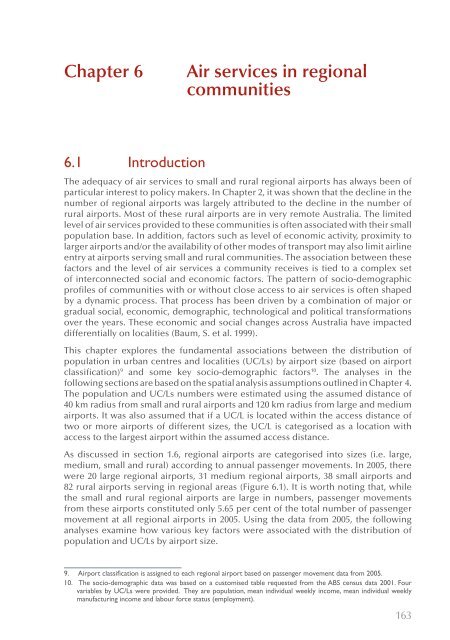PDF: 5191 KB - Bureau of Infrastructure, Transport and Regional ...
PDF: 5191 KB - Bureau of Infrastructure, Transport and Regional ...
PDF: 5191 KB - Bureau of Infrastructure, Transport and Regional ...
- No tags were found...
You also want an ePaper? Increase the reach of your titles
YUMPU automatically turns print PDFs into web optimized ePapers that Google loves.
Chapter 6Air services in regionalcommunities6.1 IntroductionThe adequacy <strong>of</strong> air services to small <strong>and</strong> rural regional airports has always been <strong>of</strong>particular interest to policy makers. In Chapter 2, it was shown that the decline in thenumber <strong>of</strong> regional airports was largely attributed to the decline in the number <strong>of</strong>rural airports. Most <strong>of</strong> these rural airports are in very remote Australia. The limitedlevel <strong>of</strong> air services provided to these communities is <strong>of</strong>ten associated with their smallpopulation base. In addition, factors such as level <strong>of</strong> economic activity, proximity tolarger airports <strong>and</strong>/or the availability <strong>of</strong> other modes <strong>of</strong> transport may also limit airlineentry at airports serving small <strong>and</strong> rural communities. The association between thesefactors <strong>and</strong> the level <strong>of</strong> air services a community receives is tied to a complex set<strong>of</strong> interconnected social <strong>and</strong> economic factors. The pattern <strong>of</strong> socio-demographicpr<strong>of</strong>iles <strong>of</strong> communities with or without close access to air services is <strong>of</strong>ten shapedby a dynamic process. That process has been driven by a combination <strong>of</strong> major orgradual social, economic, demographic, technological <strong>and</strong> political transformationsover the years. These economic <strong>and</strong> social changes across Australia have impacteddifferentially on localities (Baum, S. et al. 1999).This chapter explores the fundamental associations between the distribution <strong>of</strong>population in urban centres <strong>and</strong> localities (UC/Ls) by airport size (based on airportclassification) 9 <strong>and</strong> some key socio-demographic factors 10 . The analyses in thefollowing sections are based on the spatial analysis assumptions outlined in Chapter 4.The population <strong>and</strong> UC/Ls numbers were estimated using the assumed distance <strong>of</strong>40 km radius from small <strong>and</strong> rural airports <strong>and</strong> 120 km radius from large <strong>and</strong> mediumairports. It was also assumed that if a UC/L is located within the access distance <strong>of</strong>two or more airports <strong>of</strong> different sizes, the UC/L is categorised as a location withaccess to the largest airport within the assumed access distance.As discussed in section 1.6, regional airports are categorised into sizes (i.e. large,medium, small <strong>and</strong> rural) according to annual passenger movements. In 2005, therewere 20 large regional airports, 31 medium regional airports, 38 small airports <strong>and</strong>82 rural airports serving in regional areas (Figure 6.1). It is worth noting that, whilethe small <strong>and</strong> rural regional airports are large in numbers, passenger movementsfrom these airports constituted only 5.65 per cent <strong>of</strong> the total number <strong>of</strong> passengermovement at all regional airports in 2005. Using the data from 2005, the followinganalyses examine how various key factors were associated with the distribution <strong>of</strong>population <strong>and</strong> UC/Ls by airport size.9. Airport classification is assigned to each regional airport based on passenger movement data from 2005.10. The socio-demographic data was based on a customised table requested from the ABS census data 2001. Fourvariables by UC/Ls were provided. They are population, mean individual weekly income, mean individual weeklymanufacturing income <strong>and</strong> labour force status (employment).163
















